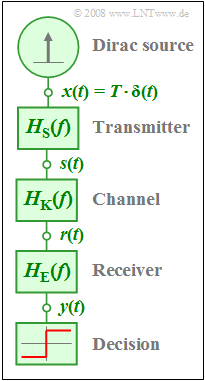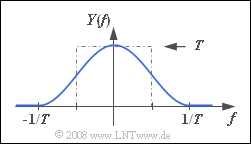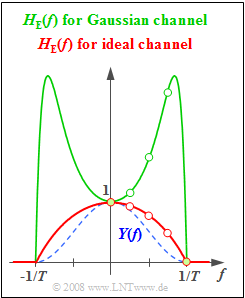Exercise 2.5Z: Nyquist Equalization
A digital baseband transmission system is modelled by the depicted block diagram.
- The "transmitter", "channel" and "receiver" components are described in the frequency domain by $H_{\rm S}(f)$, $H_{\rm K}(f)$ and $H_{\rm E}(f)$ .
- The overall frequency response $H(f) = H_{\rm S}(f) \cdot H_{\rm K}(f) \cdot H_{\rm E}(f)$ has a $\cos^2$–shaped curve:
- $$H(f) = \left\{ \begin{array}{c} \cos^2\left({\pi}/{2} \cdot f \cdot T \right) \\ 0 \\ \end{array} \right.\quad \quad \begin{array}{*{10}c} {\rm{f\ddot{u}r}} \\ {\rm{f\ddot{u}r}} \\ \end{array}\begin{array}{*{20}c} {\left| \hspace{0.005cm} f\hspace{0.05cm} \right| < 1/T,} \\ {\left|\hspace{0.005cm} f \hspace{0.05cm} \right| \ge 1/T.} \\ \end{array}$$
- The signal $y(t)$ before the decision circuit thus exhibits equidistant zero crossings at intervals of $T$ .
- It is assumed here that the source emits a Dirac-delta $x(t)$ with weight $T$ (see graph).
It is pointed out that this is a so-called "Nyquist system".
As will be discussed in detail in the book Digital Signal Transmission, these Nyquist systems represent an important class of digital transmission systems since the sequentially transmitted symbols do not influence each other in such systems.
However, these far-reaching aspects are not needed for the solution of this task.
Here, it is only assumed that
- the transmission pulse $s(t)$ be rectangular with pulse duration $T$:
- $$H_{\rm S}(f) = {\rm si}(\pi f T),$$
- der Kanal bis einschließlich Teilaufgabe (2) als ideal vorausgesetzt wird, während für die last subtask (3) gelten soll:
- $$H_{\rm K}(f) = H_{\rm G}(f) = {\rm e}^{-\pi(f \cdot T)^2} .$$
Gesucht ist für beide Kanäle der Empfänger– und gleichzeitig Entzerrerfrequenzgang $H_{\rm E}(f)$, damit der Gesamtfrequenzgang die gewünschte Nyquistform aufweist.
Please note:
- The task belongs to the chapter Linear Distortions.
- Als bekannt vorausgesetzt wird die folgende trigonometrische Beziehung:
- $$\frac{\cos^2(\alpha /2)}{\sin(\alpha )} = {1}/{2} \cdot {\rm cot}(\alpha /2) .$$
Questions
Solution
(1) Mit dem konstanten Spektrum $X(f) = T$ erhält man für die Spektralfunktion des Empfängerausgangssignals $y(t)$:
- $$Y(f)= T \cdot {H(f)}.$$
- Der Signalwert bei $t = 0$ ist gleich der Fläche unter $Y(f)$.
- Wie aus der nebenstehenden Skizze hervorgeht, ist diese gleich $1$. Daraus folgt:
- $$y(t = 0)\; \underline{= 1}.$$
(2) Aus der Bedingung $H_{\rm S}(f) \cdot H_{\rm E}(f) = H(f)$ folgt im betrachteten Bereich:
- $$H_{\rm E}(f)= \frac{H(f)}{H_{\rm S}(f)} = \frac{\cos^2(\pi f T/2)}{\sin(\pi f T)/(\pi f T)}.$$
- Wegen $\cos(0) = 1$ und ${\rm si}(0) = 1$ gilt auch $H_{\rm E}(f = 0)\;\underline{=1}$.
- Mit der gegebenen trigonometrischen Umformung gilt weiter:
- $$H_{\rm E}(f) = {\pi f T}/{2} \cdot {\rm cot}\left( {\pi f T}/{2}\right),$$
- $$H_{\rm E}(f \cdot T = 0.25) = {\pi }/{8} \cdot {\rm cot}\left( 22.5^{\circ}\right) = {\pi }/{8} \cdot 2.414 = \hspace{0.15cm}\underline{0.948},$$
- $$H_{\rm E}(f \cdot T = 0.50) = {\pi }/{4} \cdot {\rm cot}\left( 45^{\circ}\right) = {\pi }/{4} \cdot 1 \hspace{0.15cm}\underline{= 0.785},$$
- $$ H_{\rm E}(f \cdot T = 0.75) = {3 \pi }/{8} \cdot {\rm cot}\left( 67.5^{\circ}\right) = {3 \pi }/{8} \cdot 0.414 \hspace{0.15cm}\underline{= 0.488},$$
- $$ H_{\rm E}(f \cdot T = 1.00)= { \pi }/{2} \cdot {\rm cot}\left( 90^{\circ}\right) ={ \pi }/{2} \cdot 0 \hspace{0.15cm}\underline{ = 0}.$$
(3) Unter Berücksichtigung des Gaußkanals gilt:
$$H_{\rm E}(f)= \frac{H(f)}{H_{\rm S}(f) \cdot H_{\rm K}(f)} = H_{\rm
E}^{(2)}(f)\cdot {\rm e}^{\pi (f\hspace{0.05cm}\cdot \hspace{0.05cm} T)^2}.$$
Hierbei bezeichnet $H_{\rm E}^{(2)}(f)$ den bei der Teilaufgabe (2) berechneten Entzerrerfrequenzgang unter der Voraussetzung eines idealen Kanals. Man erhält folgende numerische Ergebnisse:
- $$H_{\rm E}(f\cdot T = 0) = 1 \cdot {\rm e}^{0} \hspace{0.15cm}\underline{= 1},$$
- $$H_{\rm E}(f \cdot T = 0.25) = 0.948 \cdot 1.217 \hspace{0.15cm}\underline{= 1.154},$$
- $$H_{\rm E}(f \cdot T = 0.50) = 0.785 \cdot 2.193 \hspace{0.15cm}\underline{= 1.722},$$
- $$H_{\rm E}(f \cdot T = 0.75) = 0.488 \cdot 5.854 \hspace{0.15cm}\underline{= 2.857},$$
- $$H_{\rm E}(f \cdot T = 1.00) = 0 \cdot 23.141 \hspace{0.15cm}\underline{= 0}.$$
Die grüne Kurve in obiger Grafik fasst die Ergebnisse dieser Teilaufgabe zusammen.


